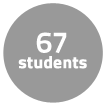Instructor Insights pages are part of the OCW Educator initiative, which seeks to enhance the value of OCW for educators.
Course Overview
This page focuses on the course 1.264J Database, Internet, and Systems Integration Technologies as it was taught by Dr. George Kocur in Fall 2013.
The course focuses on defining an engineering and business software system, producing a working version quickly, managing the overall process, and becoming very familiar with database and Web technologies that are central to current software systems. The course has no programming, except that students write database queries in SQL; the system is built using a set of tools that do not require software coding.
Course Outcomes
Course Goals for Students
The goal is for students to learn to design, implement and manage engineering and business software systems. It’s an engineering course, and students build a system during the term. As part of the course, students learn about project management, software modeling (UML), databases, the Internet and Web, security, and data communications.
Curriculum Information
Prerequisites
- Permission of the instructor
Requirements Satisfied
- H-Level Graduate Credit

- Master of Engineering in Logistics degree requirement
- Master of Engineering - Transportation degree requirement
- Master of Science - Transportation information technology requirement
Offered
- Every fall semester

Enrollment
The enrollment in this course in Fall 2013 was 67. The average enrollment is 54.
Breakdown by Year
The students are first-year master’s degree students in non-computer science majors.
Breakdown by Major
Most students are in master’s programs for transportation engineering or logistics/supply chain, but there are also students from several other engineering backgrounds.
Typical Student Background
About half of the students have a few years of work experience, and about half of the students come directly from an undergraduate program. They typically have limited experience with software and systems.
During an average week, students were expected to spend 12 hours on the course, roughly divided as follows:
Lecture
- Met 3 times per week for 1.5 hours per session; 39 sessions total
- Based around lectures, with an in-class exercise during most sessions
- Discussion of case studies
- Two class sessions were spent on exams
Out of class
Semester Breakdown
Assignments were due during nearly every class session. For a detailed list of assignment deadlines, see the course calendar.
| WEEK | M | T | W | Th | F |
|---|---|---|---|---|---|
| 1 |  |  |  |  |  |
| 2 |  |  |  |  |  |
| 3 |  |  |  |  |  |
| 4 |  |  |  |  |  |
| 5 |  |  |  |  |  |
| 6 |  |  |  |  |  |
| 7 |  |  |  |  |  |
| 8 |  |  |  |  |  |
| 9 |  |  |  |  |  |
| 10 |  |  |  |  |  |
| 11 |  |  |  |  |  |
| 12 |  |  |  |  |  |
| 13 |  |  |  |  |  |
| 14 |  |  |  |  |  |
| 15 |  |  |  |  |  |
| 16 |  |  |  |  |  |
 No classes throughout MIT
No classes throughout MIT Lecture session
Lecture session Exam
Exam No class session scheduled
No class session scheduled Due dates (homework, case studies, in-class exercises)
Due dates (homework, case studies, in-class exercises)

 Room 1 of 1
Room 1 of 1 